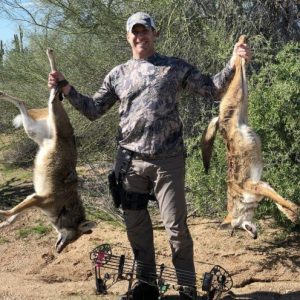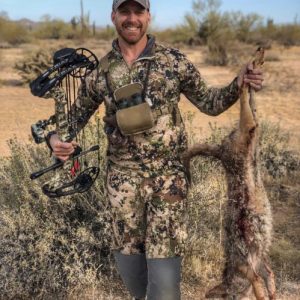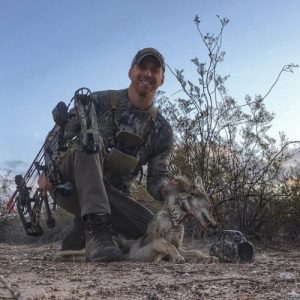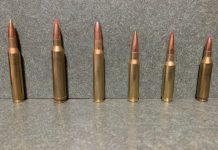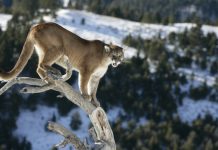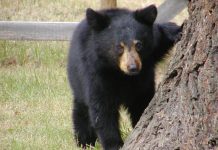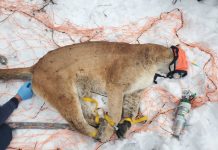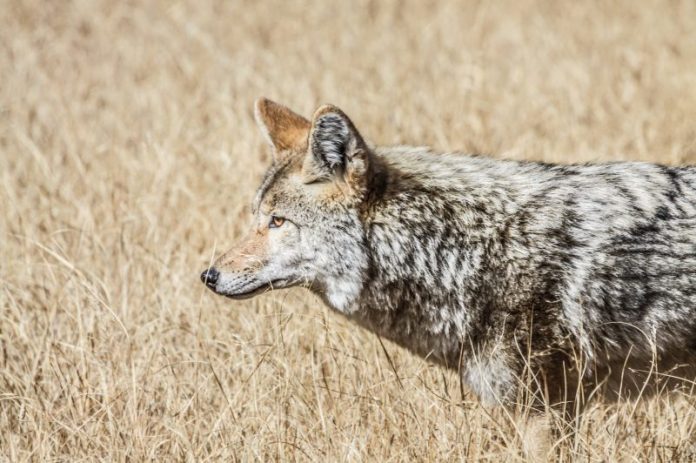
Whether you’re a beginner or a seasoned predator hunter, it’s tough to get a coyote, or any predator for that matter, with a bow. They come in hot, super alert, and can jump a string faster than any deer I have seen. Consequently, I have developed a couple tricks over the years to get predators within bow range for a good shot.
Before I go over these tricks it is important to remember that unlike firearm hunting where the setup is less important than location, archery hunting requires precision when setting up your stand and equipment. That alone will make the difference between getting a coyote or watching him run away leaving you wishing you had your shotgun. Having said that, it goes without saying that if you’re not calling where coyotes and other predators “hang” then the best set up in the world isn’t going to help you. Doing your homework, finding travel corridors, bedding areas and “hunting grounds” are key to having a response to your call.
YouTube:Predator Hunting Part 1
Now, back to the lecture at hand. Finding a good set up to score a coyote with a bow is made up of several key components: approach, wind direction, vantage point, and concealment.
Approach
I like to enter an area with an ”L” shaped approach by walking with the wind in my face then taking a hard 90-degree angle so the wind ends up approaching me from the side, instead of in my face. Why? Because more times than not a predator (especially cats) will approach from downwind, which means they will come from behind you if the wind is in your face. Putting the wind to your side will often make them cross in front of you broadside. I also try to approach my stand by avoiding the area that I believe they will come from. If I don’t have these advantages in my approach, I don’t bow hunt that spot, period.
Wind Direction
I already talked about using the wind to your advantage in the approach but there are a couple other tricks that will assist in using the wind to your advantage. First, I prefer wind under 15 mph and above 5 mph. This helps to conceal your movement when you go to draw, and the bushes/vegetation around you will be moving a bit to conceal your movement. Second, when possible I like the wind going away and across from me in the area I think is holding the coyotes. However, if the wind is going towards the coyotes, that’s OK because laying a little scent down (rabbit distress or fox urine) will add illusion. Third, and speaking of illusion, decoys are a good tool for this set up as well.
Vantage Point
The terrain doesn’t always lend itself to this but I like to have a vantage point, even if it’s just a little rise or rock outcropping. There is a great advantage having the terrain sloping away from you, even if it’s a slight slope. When such is not possible, I look for small open parks just big enough to shoot across at 50 yards or less. If that is not possible either, I look for edge cover. With edge cover, I am basically looking for something that gives me the advantage of seeing them before they see me. If you can couple this with good concealment, you will improve your odds of getting a shot off.
YouTube:Predator Hunting Part 2
Concealment
Aside from having good camo and controlling your scent, your vantage point should be a counterpart to your concealment. In fact, it’s probably the most important piece to the puzzle. I try to look for a tree or shrubbery that I can sit down under, against, or even better in. Once I have found such a spot, I clear the area around it to remove anything that may give me away or make noise. Even though I have cleared the area around my spot I still like to have some brush or deadfall in front of me to help break me up but not take away my ability to shoot.
I also check my draw and make sure I have clearance and the ability to shoot at all my open points or lanes. Shade is another great tool for concealment, especially if the shade is just covering you and creates an edge just beyond your position. Using shade to your advantage also requires being aware of the position of the sun. The sun is your friend if you can keep it behind you. Nothing works better getting a dog to stop and stare for that extra moment than having the sun at your back and in the coyote’s eyes. In that same vein, avoid having the sun in your face at all costs because it will defeat your concealment even if you have a bit of top shade.
Bonus Info
With the above tips, you are well prepared to take a coyote with a bow after you sweet talk one in close enough to shoot. I recommend using an electronic game call, like a FoxPro, so you can have your hands free while calling, as you can see in my videos. If you use an electronic caller such as a FoxPro, there are several tricks to keep in mind: point the call in the direction you want them to come from, place the call under or behind something so they have to come around that obstacle to get at it, and set the call 20-25 yards away and at an angle so they have to come across to get to it. Good luck and we will see ya out in the field.
To listen to the full podcast on the subject click here. Anyone else have any luck on coyotes with a bow?


